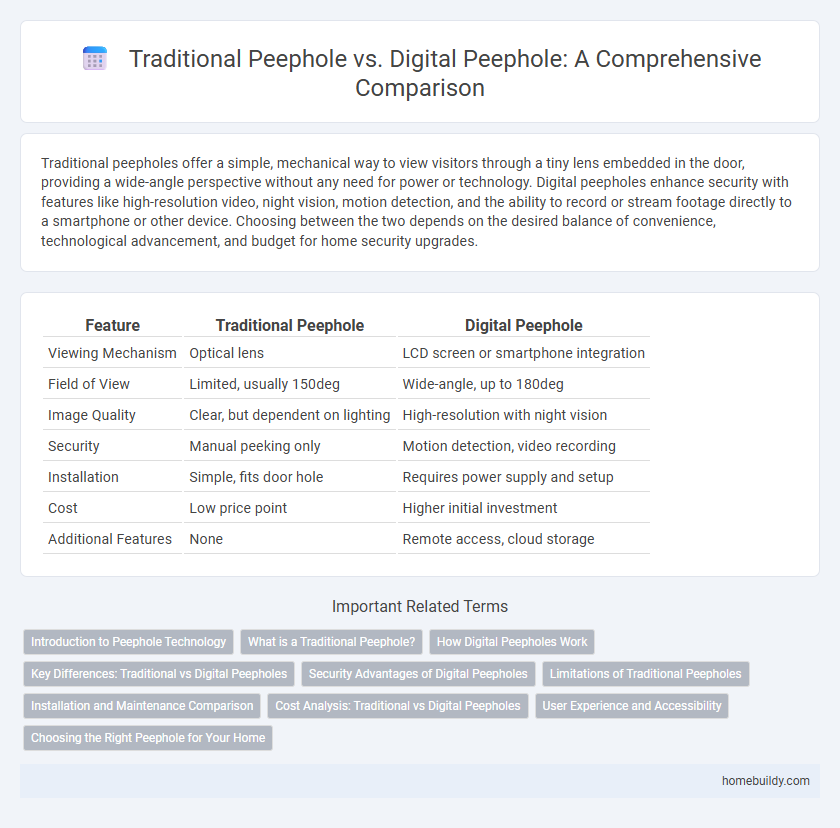Traditional peepholes offer a simple, mechanical way to view visitors through a tiny lens embedded in the door, providing a wide-angle perspective without any need for power or technology. Digital peepholes enhance security with features like high-resolution video, night vision, motion detection, and the ability to record or stream footage directly to a smartphone or other device. Choosing between the two depends on the desired balance of convenience, technological advancement, and budget for home security upgrades.
Table of Comparison
| Feature | Traditional Peephole | Digital Peephole |
|---|---|---|
| Viewing Mechanism | Optical lens | LCD screen or smartphone integration |
| Field of View | Limited, usually 150deg | Wide-angle, up to 180deg |
| Image Quality | Clear, but dependent on lighting | High-resolution with night vision |
| Security | Manual peeking only | Motion detection, video recording |
| Installation | Simple, fits door hole | Requires power supply and setup |
| Cost | Low price point | Higher initial investment |
| Additional Features | None | Remote access, cloud storage |
Introduction to Peephole Technology
Peephole technology enables secure door viewing by providing visual access to visitors without opening the door. Traditional peepholes use a simple convex lens to offer a wide-angle view, while digital peepholes incorporate cameras and digital displays for enhanced clarity and additional features like recording and remote monitoring. Advances in digital peephole technology improve home security by integrating with smart home systems and offering real-time video transmission.
What is a Traditional Peephole?
A traditional peephole is a small, convex lens installed in a door that allows occupants to see outside without opening it, providing basic visual security. It offers a limited field of view and requires the viewer to be close to the door to look through the fisheye lens. Unlike digital peepholes, it does not record or store images and operates without needing power sources.
How Digital Peepholes Work
Digital peepholes utilize a small camera lens installed on the door's exterior, capturing high-resolution images or video. These visuals are transmitted to an internal LCD screen or connected smartphone via Wi-Fi or Bluetooth, enabling remote viewing and enhanced security features. Unlike traditional peepholes, digital models often include motion detection, night vision, and recording capabilities for comprehensive monitoring.
Key Differences: Traditional vs Digital Peepholes
Traditional peepholes offer a simple optical lens allowing users to view the area outside their door with limited field of vision and no recording capability. Digital peepholes utilize a camera, LCD screen, and sometimes Wi-Fi connectivity to provide a wider viewing angle, video recording, and remote access through smartphone apps. Key differences include image quality, security features, and convenience, with digital peepholes providing enhanced functionality over traditional models.
Security Advantages of Digital Peepholes
Digital peepholes provide enhanced security by offering high-definition video footage that eliminates the distortion common in traditional peepholes. They allow remote viewing and recording capabilities, enabling homeowners to monitor visitors and potential threats in real time through smartphone integration. Advanced features such as motion detection alerts and night vision further increase safety, making digital peepholes a superior choice for residential security.
Limitations of Traditional Peepholes
Traditional peepholes suffer from narrow viewing angles and low visibility during nighttime or low-light conditions, limiting their effectiveness in identifying visitors. They provide a restricted field of vision, often requiring the user to be very close to the door to see clearly. Additionally, traditional peepholes lack the ability to record or capture images, offering no security data or remote monitoring capabilities.
Installation and Maintenance Comparison
Traditional peepholes require simple installation involving drilling a small hole through the door, offering a low-maintenance solution with minimal upkeep. Digital peepholes demand more complex installation, often needing power sources and mounting of electronic components, but they provide enhanced features such as video recording and remote viewing. Maintenance for digital peepholes includes regular software updates and battery replacements, while traditional peepholes are virtually maintenance-free.
Cost Analysis: Traditional vs Digital Peepholes
Traditional peepholes typically cost between $5 to $20, offering a low upfront investment with minimal maintenance expenses. Digital peepholes range from $100 to $300, incorporating cameras, displays, and smart features that increase both initial costs and potential energy consumption. When considering long-term value, digital peepholes provide enhanced security and convenience but require a higher financial commitment compared to the basic optical design of traditional models.
User Experience and Accessibility
Traditional peepholes offer a simple, low-cost method for door security, but require users to physically align their eye with the viewer, which can be challenging for individuals with mobility or vision impairments. Digital peepholes enhance user experience by providing larger, high-resolution screens and remote viewing capabilities via smartphone apps, improving accessibility for elderly users or those with disabilities. Features such as motion detection and adjustable viewing angles in digital peepholes further elevate safety and convenience compared to their traditional counterparts.
Choosing the Right Peephole for Your Home
Choosing the right peephole for your home requires evaluating security, convenience, and technology integration. Traditional peepholes offer a simple, cost-effective solution with a fixed viewing angle and no electronic components, while digital peepholes provide enhanced features like wide-angle views, video recording, and smartphone connectivity. Homeowners should consider installation ease, privacy concerns, and desired functionality to select a peephole that best fits their security needs and lifestyle.
Traditional Peephole vs Digital Peephole Infographic

 homebuildy.com
homebuildy.com